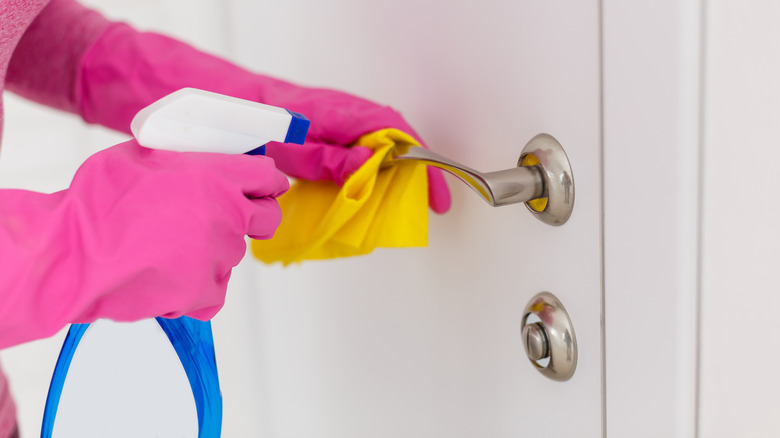The Type Of Hardware You Should Never Spray With Glass Cleaner (& What To Use Instead)
When it comes to deep cleaning the fixtures in your home, it's unfortunately not a one-size-fits-all type of situation. Different materials, from wood and glass to natural stone and chrome, all require various types of cleaning products. While glass cleaner may be a godsend for removing grease from kitchen countertops, it can actually weaken any nickel fixtures in your home and should be avoided for that type of material. When it comes to cleaning nickel, the most popular solution is easier than you might think. You will only need a bit of water and dish soap.
Glass cleaners, like Windex, typically contain the chemical ammonia, which may work wonders on glass, but can ultimately damage nickel. Ammonia can weaken nickel fixtures and even cause them to peel or discolor. This metal can be a tough material to clean, especially if you're trying to scrub away hard water stains. But there are a few DIY options you can try that won't damage the surface.
What you should use to clean nickel fixtures
The best way to clean nickel hardware is to avoid using any harsh cleaners that contain bleach, ammonia, or alcohol. You may see some online DIY recipes that include vinegar, but this is another liquid to be avoided, especially on brushed nickel, as the acidity can dissolve the material and expose the metal underneath. (Nickel is typically used as a plating over top of another metal, like copper, steel, brass, or aluminum.)
While you can always purchase a specialized nickel polish for your fixtures, there is a much easier and more affordable option: warm water. You can add dish soap to the mix if you're having a tough time removing the stains. As for tools, avoid using scrubbing brushes or anything with rough textures and opt for a microfiber cloth. Simply wet the cloth to gently rub off any spots or hard water stains. If they're stubborn, add a few drops of dish soap or dishwasher detergent to the cloth. Make sure to dry the fixture off immediately with a dry cloth to avoid leaving any spots behind.
If the water deposit stains are still visible, you can dampen your cloth with hot water and secure it around the affected area, allowing it to sit for about 10 minutes. Once the time is up, wipe the area with your dry cloth, and the spots should dissolve.

